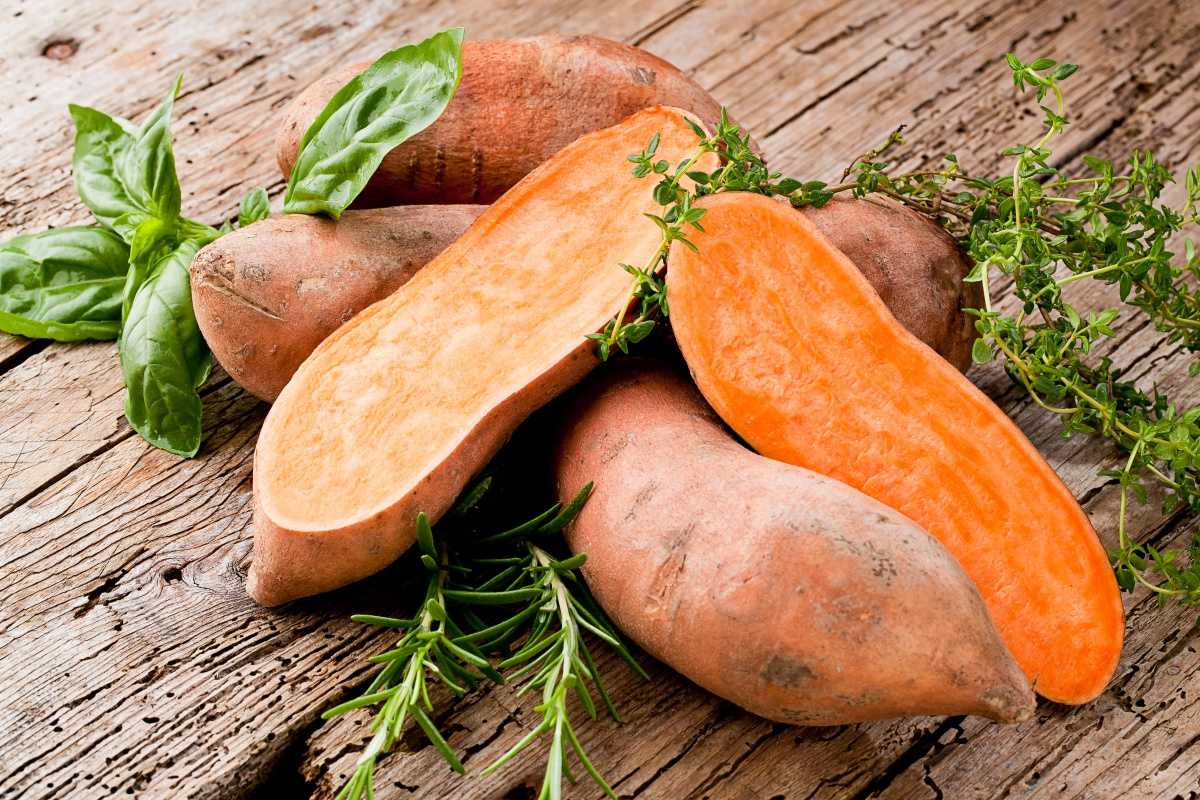7 Signs Your Sweet Potato Has Gone Bad
Sweet potatoes are a delightful nutrient-rich root vegetable, renowned not only for their health benefits but also for their delectable taste.
Many have made the switch from regular potatoes to sweet potatoes, enticed by their richer flavor profile. However, like most fresh produce, sweet potatoes are not exempt from spoilage, especially given their high water content.

A simple glance might not always suffice, as appearances can be deceiving. To ensure the freshness of your sweet potatoes, it might be necessary to look a bit deeper, exploring aspects like smell and texture.

Also, check out some of my favorite sweet potato recipes, like air fryer sweet potato cubes, sweet potato brownies, or sweet potato pancakes.
How to Spot a Bad Sweet Potato
Sweet potatoes are a popular choice for many meals. But, like other veggies, they can go bad over time. Here’s a simple guide to help you spot the signs of an aging or rotten sweet potato so you know when to eat sweet potatoes or toss them.
If you want to know how to tell when pork, asparagus, garlic, or onion have gone bad, check out my other articles.

Brown Patches
As sweet potatoes get older, they can have small brown spots. If you see these, it’s a hint that you should use that sweet potato soon before it goes completely bad.
Skin Color Changes
Depending on the type, a sweet potato’s skin will darken as it gets older. The usual orange ones turn a deep brown or even black.
Meanwhile, purple-skinned ones go from a red shade to a darker purple, and their inside starts turning a bit yellow.
Sprouting
Little growths, or sprouts, might pop up from the potato. If they grow long, they could turn into roots. If you plant these sprouting sweet potatoes, they could grow into new ones!

Tiny Holes
Sometimes, there are small holes in the potato’s skin or inside it.
These happen because of changing weather when they grow. They’re safe to eat, but the potato might not taste as rich.
Mould or Soft Spots
If you see a white or grey-green furry spot, you can peel it off, and the inside should still be good. But, if you notice black spots, that’s a sign of fungus.
It’s better to throw these potatoes away because they might make your stomach upset and won’t taste good.
Odd Smell
A sweet potato that’s going bad has a specific smell. It starts sweet, then turns sour, and finally, it smells like old compost. If it smells off, it’s best not to eat it.
Feel and Look Inside
If you cut open a sweet potato, a fresh one feels firm and has a bright color. But a bad one feels soft, and stringy, and might have uneven colors and visible white threads inside. It’s best to avoid eating these.
If you notice these signs on your sweet potatoes, it’s a good idea to check their freshness before cooking or eating.
What Does Bad Sweet Potatoes Look Like Inside?
A bad sweet potato typically appears dry inside, which can compromise its flavor and texture.
They can also develop internal holes if stored in overly warm conditions. It’s wise to select another if you encounter these signs.
How Long Before a Sweet Potato Goes Bad?
Sweet potatoes are great because you can use them in both sweet and savory dishes.
Freshly harvested sweet potatoes offer the best flavor, especially if sourced locally. They can stay good for a while if you store them right, but how long depends on a few things.
And because uncooked sweet potatoes are watery, they can get old faster.

Here’s a simple guide to help you know how long sweet potatoes last:
- Raw Sweet Potatoes:
- Pantry: They can be good for up to 5 weeks.
- Fridge: They’ll last even longer here, about 3 months.
- Cooked Sweet Potatoes:
- Room Temperature: They won’t stay good for long, just a few hours.
- Fridge: In a sealed container, they’ll be fine for up to a week.
- Freezer: You can keep them frozen for up to six months. But once you thaw them, try to eat them within 2-3 days.
- Bottled or Canned Sweet Potatoes:
- Pantry: They can stay good for up to a year. Handy for any time you want some good sweet potatoes! But once you open the can or jar, put them in the fridge and eat within a week.
- Prepared Sweet Potato Foods (like fries or mash):
- Freezer: They’ll be good for 4-6 months. But after thawing, eat them in 2-3 days.
How to Store Sweet Potatoes?
The best way to store raw sweet potatoes is to leave them unwashed.
Put the unwashed sweet potatoes in a cool and dark place. Wash them only when you’re about to use them.
And remember, keep them away from other fruits and veggies because they can make sweet potatoes bad faster! Store your sweet potatoes the right way, and you’ll always have them fresh and tasty when you need them.

Can You Freeze Sweet Potatoes?
Absolutely!
But as I mentioned earlier, you need to cook them first. For instance, I often make my sweet potato pudding, freeze it, and then reheat the frozen sweet potatoes when I need it.
Whether you slice them or mash them, make sure you pack them in a tight, freezer-safe container. They will remain fresh for up to six months when stored this way.
Just a heads-up: freezing raw sweet potatoes is not the best move. They don’t last as long. So, give them a quick cook and then freeze away!

Can I Store Sweet Potatoes on the Kitchen Counter?
If you’re keeping sweet potatoes on the kitchen counter, you might want to reconsider. They’ll start to sprout and change color quickly because of the light and warmth.
Damp places speed up their aging process, too. Moisture can get into the thin skin of the potato, leading to mold and a musty smell within weeks.
For the freshest sweet potatoes, it’s best to store them in a pantry, fridge, or even the freezer. Just follow the right steps for each spot to make sure they stay good for as long as possible.

Final Thoughts
Picking the best sweet potatoes can make your meals even more delicious. But like all fresh produce, they don’t last forever.
Therefore, learning to spot the signs of an aging or spoiling sweet potato is essential. From subtle skin changes to distinctive odors, these indicators are your allies in ensuring you use only good potatoes.
Remember, it’s not just about taste; it’s about safety, too. By being attentive to these signs, you not only ensure delightful flavors but also protect your health and that of your loved ones.
So, the next time you’re in the kitchen, take a moment to inspect your sweet potatoes to ensure that you’re consuming only fresh sweet potatoes.



